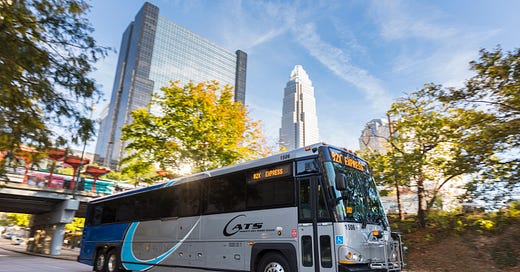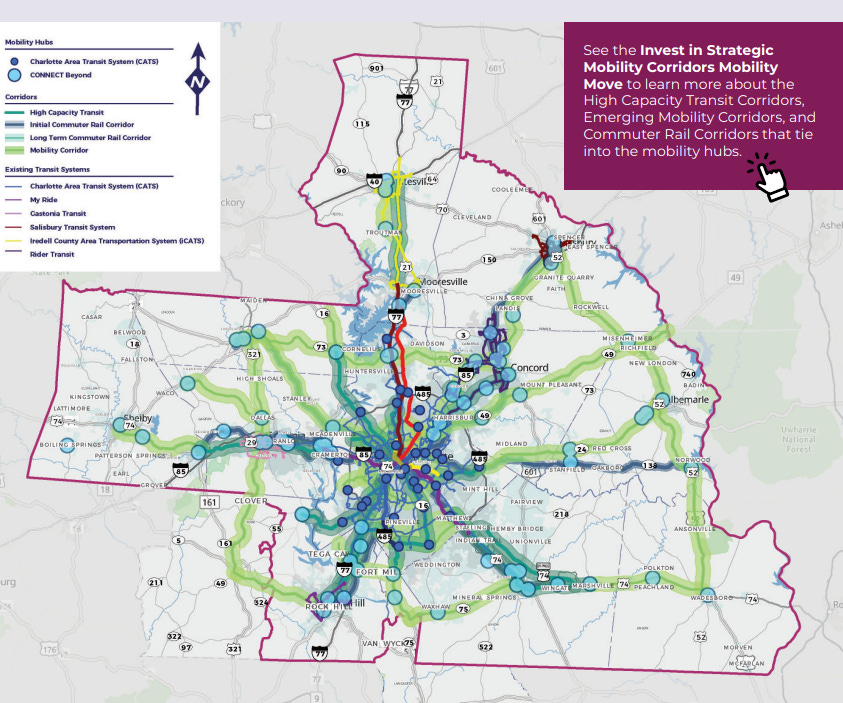Is regionalism heading in reverse?
CATS used to run 7 bus routes outside Mecklenburg. By this fall, it will have 2.
You’re reading Transit Time, a weekly newsletter for Charlotte people who leave the house. Cars, buses, light rail, bikes, scooters … if you use it to get around the city, we write about it. Transit Time is produced in partnership between The Charlotte Ledger and WFAE.
Charlotte wants its transit plan to be region-wide. But a neighboring county is backing out of express buses, citing low ridership
by Steve Harrison, WFAE
For nearly 20 years, Union County has helped pay for the Charlotte Area Transit System’s express bus route 74x, which brings commuters from Monroe to uptown Charlotte.
But Union County has said, “no more.”
Commissioners voted unanimously on April 17 to stop funding the route, citing low ridership.
It would have cost the county $86,000 a year to continue the service, which CATS said will now likely end by October.
The loss of the 74x is not a significant story in terms of transit operations. It carries only a few hundred riders a month.
But it’s a huge political story as the city of Charlotte pushes a $13.5 billion transit plan. Charlotte leaders have said their new focus is to build a regional consensus for transit, by getting neighboring counties to support and help pay for the plan. The idea is to show the Republican-controlled legislature that Republican-controlled counties neighboring Charlotte also want more transit.
But if Union County won’t pay for a single bus route, it’s unlikely people in the county would agree to tax themselves to bring rail transit or more buses in from Charlotte.
“I don’t think there is an appetite to raise taxes to help fund that,” Union Commission chairman Stony Rushing said. Charlotte’s plans call for running the Silver Line light rail to Matthews and possibly into Union County, with a final stop at Indian Trail. [corrected 5/15/23 with correct final stop]
The 74x started operating in 2004. It may end this year. (Photo courtesy of Charlotte Area Transit System)
Bus service outside Mecklenburg is shrinking
Charlotte’s goals for a regional transit network are spelled out in a report called Connect Beyond, which lays out a “bold regional transit vision and plan that provides real mobility solutions and opportunities for residents and visitors across two states and 12 counties.”
Connect Beyond, produced by the Centralina Regional Council in partnership with CATS, proposes a number of inter-county bus routes, connecting Charlotte with places like Lincoln, Gaston, Iredell, Cabarrus, Union and York counties. Those routes would be cheaper and could start far more quickly than light rail — which would take about two decades to complete, even under the rosiest scenarios. Bus lines could also reach many more destinations.
What the report doesn’t say is that many of these bus routes were already launched and then discontinued for lack of interest.
At the start of the last decade, CATS operated seven express bus routes that went outside Mecklenburg County. The system had also operated an express bus to Lincoln County, though that ended in 2009 when the county decided it wasn’t worth the money.
When the 74x ends, there will be only two inter-county CATS buses remaining — to Rock Hill and Gastonia.
‘The world has changed’
Connect Beyond doesn’t mention bus routes once operated in many of these corridors.
The 74x starts in Monroe and reaches uptown about 50 minutes later. There are three trips in the morning and three in the afternoon.
A decade ago, the route carried about 3,800 passengers each month.
But by March 2019, that had fallen to 2,480 passengers. In March of 2022, it carried 664 passengers. In March of 2023, it carried 693.
That works out to about five passengers on each bus departure. The total cost to CATS and Union County combined is about $20 per passenger trip, not including fare revenue.
“Ridership had been declining pre-Covid,” Union County transportation planner Bjorn Hansen told commissioners at the April meeting. “And then during Covid, it declined a lot. It’s coming back, but not very much. The world has changed, and we don’t expect ridership to get back to where it was before.”
Many of uptown Charlotte’s biggest employers are still letting employees work from home at least several days a week. It’s a trend that’s dramatically impacted transit across the nation.
Transit ridership nationwide still hasn’t reached pre-pandemic levels. Among large transit systems, CATS has had one of the slowest recoveries, at 58% of pre-pandemic ridership, according to the group transitrecovery.com.
Union County plans to spend the money saved on the 74x for its own local on-demand transit service.
Union County’s departure ‘obviously not a good sign’
The city of Charlotte has been trying to build support for its $13.5 billion transit plan since 2020, but it has made little progress.
In January, Republican House speaker Tim Moore blasted the city’s plan, saying Charlotte wants to spend too much money on trains, buses and bike lanes. He said the plan needs more money for roads.
Moore’s support is critical because the Republican-controlled General Assembly must give the OK to place a proposed sales tax increase on Mecklenburg’s ballot.
After Moore’s comments, the city shifted gears. Charlotte began talking about a new plan to build a regional consensus for transit and go to Raleigh with a unified voice — including support from Republican-controlled counties.
“If we were to go out there to the General Assembly with the bill the City Council wanted, it wouldn’t be a regional plan,” city of Charlotte lobbyist Dana Fenton told council members during a strategy retreat earlier this year. “It would be seen as a city of Charlotte plan, and it would be dead on arrival. And it wouldn’t go anywhere. If we were to do that, it would really hurt this effort to get a new source of revenue.”
Republican Charlotte City Council member Ed Driggs, who chairs the transportation committee, has been working to be a bridge between the largely Democratic city and the GOP-controlled General Assembly.
When asked what Union County’s decision means for the regional plan, Driggs said, “It’s obviously not a good sign — I guess I’ll put it that way.”
But he added that the city is only in a “formative phase” of defining how the Connect Beyond plan would work. He said that’s a far bigger issue than the loss of a single bus route.
Council member Ed Driggs says Union County’s vote can be overcome.
But Charlotte faces a problem in that its neighbors are very different culturally. Surrounding counties are low density. And they are conservative politically, reluctant to raise taxes.
Transit Time asked Chad Brown, the chair of the Gaston County Commission, whether he would support some sort of tax increase to pay for a regional transit system.
“We do not plan on it, nor will we raise taxes to do so,” he said.
Rushing, the Union County Commission chair, said the same thing.
But Cabarrus County Commission chair Stephen Morris earlier this year left the door open to working with Charlotte.
He said he would be open to considering a quarter-cent sales tax increase for transit. He said transportation has become a “bigger issue” and that allowing voters to decide “would be worthy of consideration.”
Does Charlotte do it alone?
Charlotte Mayor Vi Lyles has said it’s important for the city to move quickly to be eligible for billions of dollars from President Biden’s infrastructure bill.
If that’s the case, Charlotte might have to consider moving forward on its own, bypassing the General Assembly.
The city could slash the scope of its transit plan and focus only on building part of the Silver Line. To fund it — or to fund part of it — the city could raise property taxes, just as Austin, Texas, has done for transit.
Charlotte could then seek federal and state funding.
It would not be a transformative plan. But it would be a start.
Steve Harrison is a reporter with WFAE, Charlotte’s NPR news source. Reach him at sharrison@wfae.com.
Related Transit Time articles:
“How to build a regional transit system” (Nov. 3, 2022 — 🎧 with accompanying podcast)
“New strategy for transit plan: Go regional” (Sept. 22, 2022)
“Buses eyed as the key to regional transit system” (June 3, 2021)
In brief…
Road projects delayed: The N.C. Department of Transportation has pushed back the construction dates for 16 road projects in Mecklenburg, Union and Iredell counties. Five of the delayed projects involve U.S. 74. (South Charlotte Weekly)
School bus driver vacancies: Charlotte-Mecklenburg Schools sent text messages to some parents this week saying their children’s buses had no drivers and that parents would need to “connect with your student regarding their plan to get home.” A district spokesman said CMS has 58 driver vacancies, double the number from January. (Ledger 🔒)
City sues vendor over CATS ads: The city of Charlotte is suing the company it hired to sell ads on buses and light rail trains, saying Vector Media Holding underpaid the city by more than $1.5M. A Vector spokesperson said the dispute stems from the “significant reduction” in public transit service during the pandemic. (Observer)
‘Frankensteined’ guardrails: Some guardrails along highways in North Carolina and other states were assembled using mismatched parts from different manufacturers, which some safety advocates say creates potential safety hazards. (WCNC)
Transit Time is a production of The Charlotte Ledger and WFAE. You can adjust your newsletter preferences on the ‘My Account’ page.
Did somebody forward you this newsletter and you need to sign up? You can do that here:
Other affiliated Charlotte newsletters and podcasts that might interest you:
The Charlotte Ledger Business Newsletter, Ways of Life newsletter (obituaries) and Fútbol Friday (Charlotte FC), available from The Charlotte Ledger.
The Inside Politics newsletter, available from WFAE.









The proposed rail line would end in Indian Trail, not Indian Land. As a former 74X rider its a shame to lose the service. But the timing of the bus was not convenient for a lot of commuters. Two of the return buses departed uptown before 5pm. A lot of people who returned to the office after Covid switched to the 64X in Matthews, which runs more frequently. Additionally, the Indian Trail Park and Ride was off of 74 behind a Food Lion, versus closer to the doorstep of many of the communities in IT. A bus that picked up in Sun Valley Commons, Downtown Indian Trail, Lake Park or along Seacrest Shortcut would be more successful in my opinion.
As a former public transit commuter in Boston, other than well-appointed express buses, most commuters prefer rail transit over buses. As a growing metropolitan area, with congested roads, the Charlotte region really needs rail transit which is expensive to build but the longer it is delayed, the more exponentially expensive it becomes.